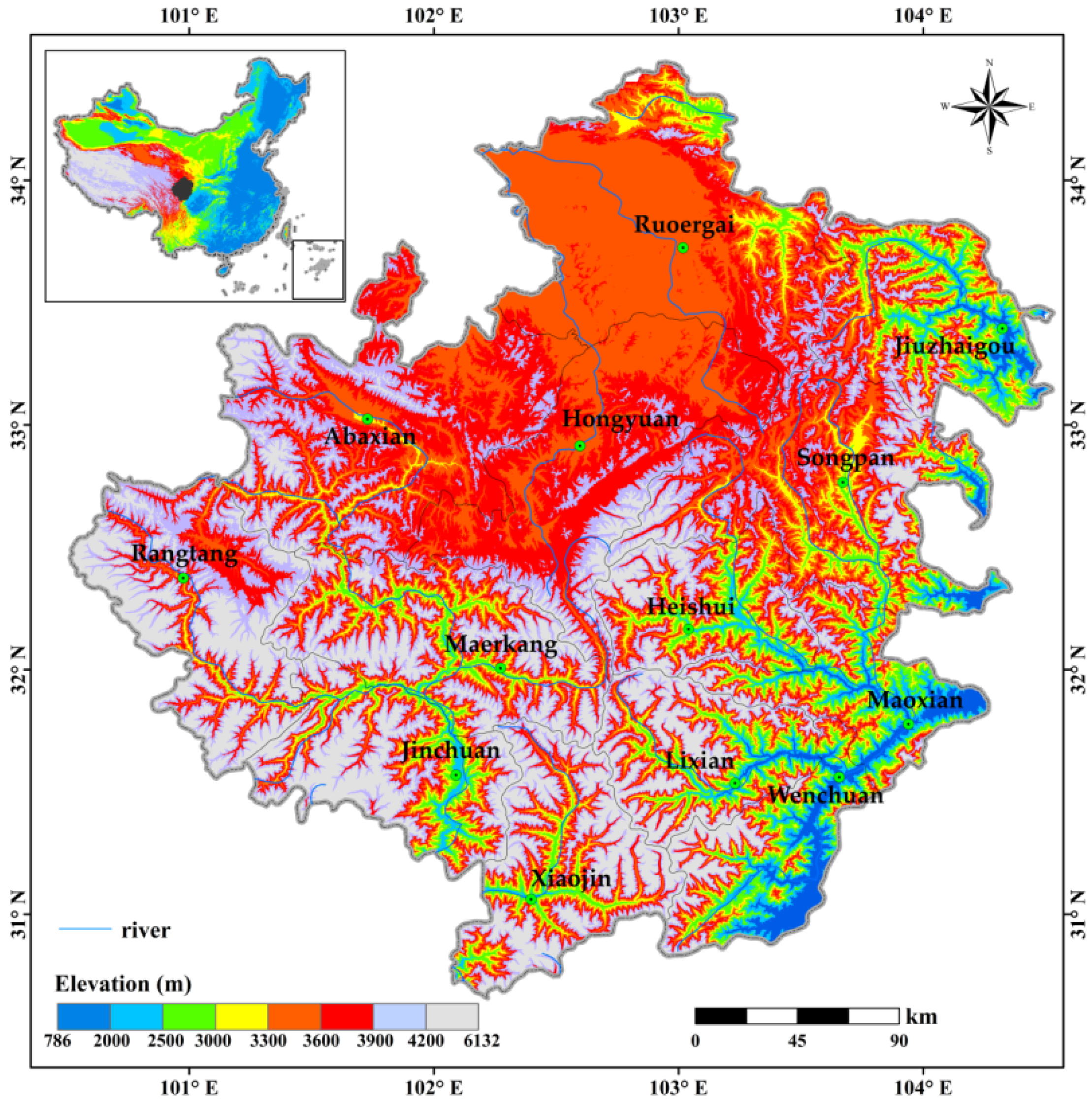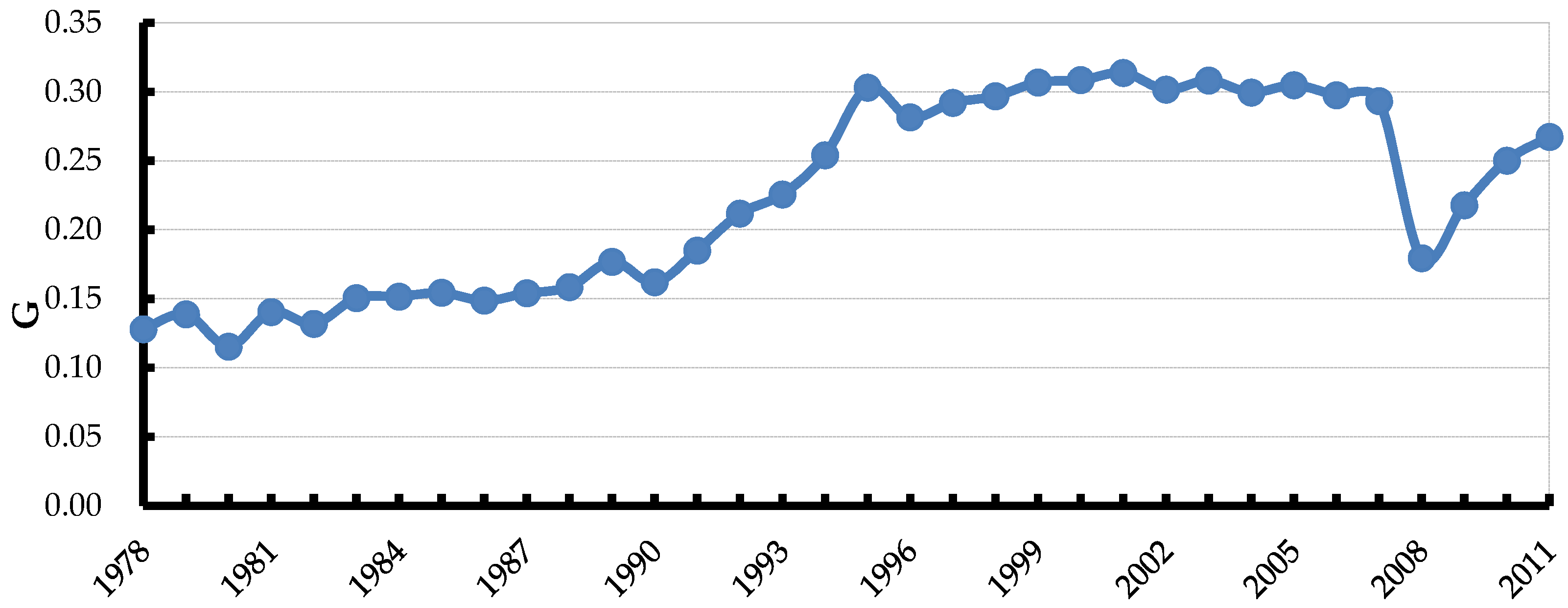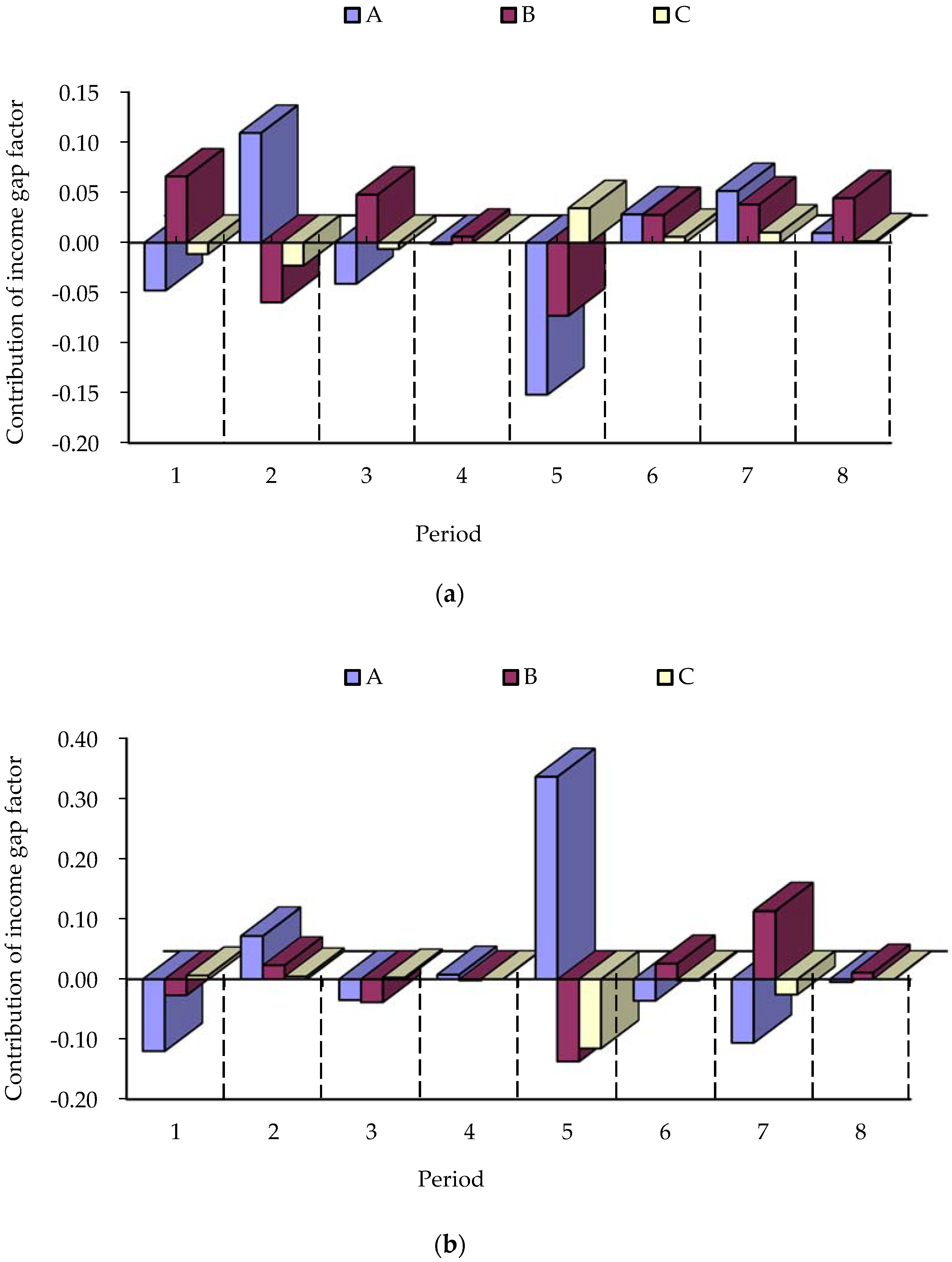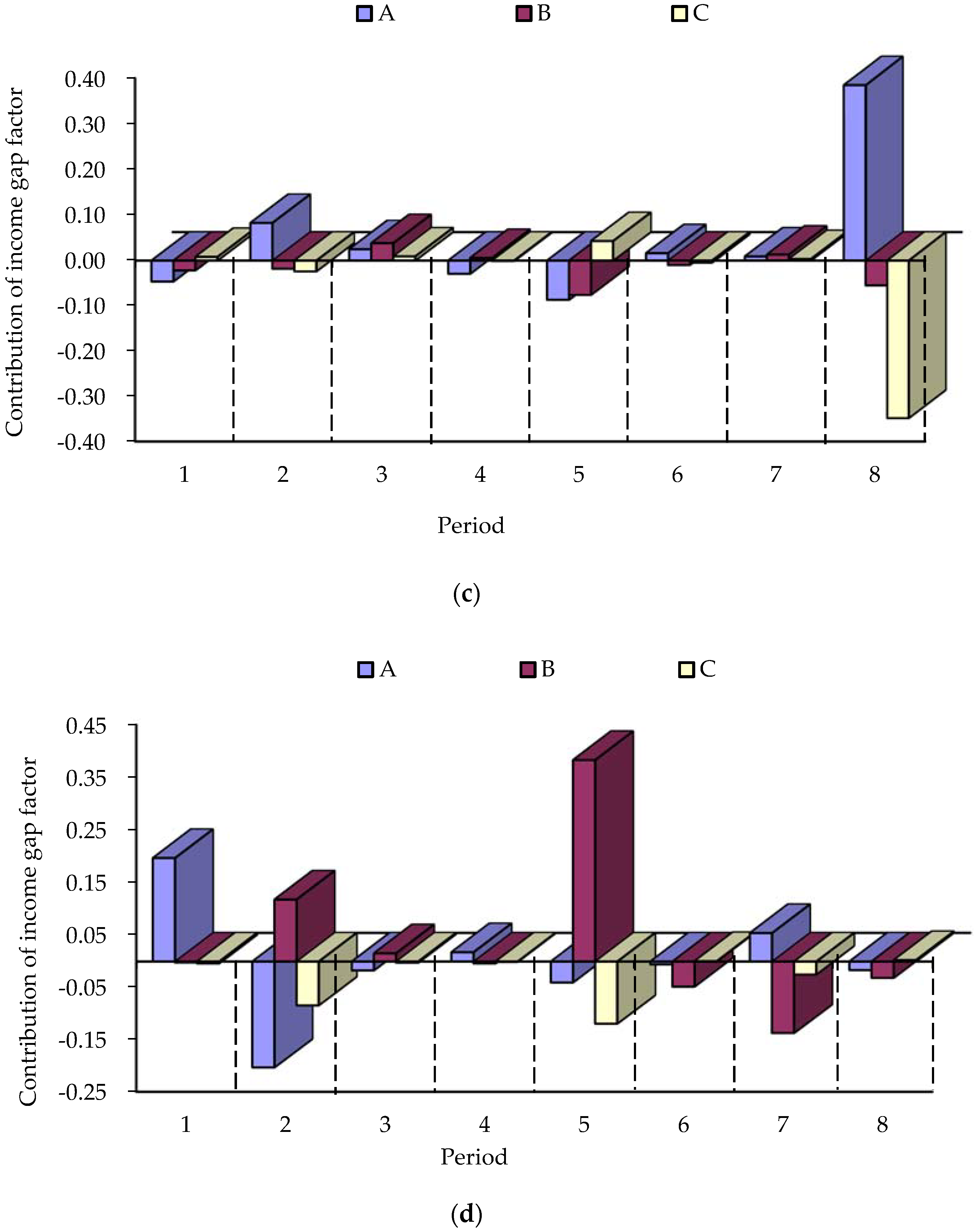Factor Decomposition of the Changes in the Rural Regional Income Inequality in Southwestern Mountainous Area of China
Abstract
:1. Introduction
2. Materials and Methods
2.1. Study Area
2.2. Methods
2.2.1. Data Sources
2.2.2. Measuring Method of Rural Regional Income Inequality
2.2.3. Decomposing Method of Rural Regional Income Inequality
3. Results
3.1. Characteristics of Rural Income Inequality
3.2. Composition Changes in per Capita Annual Net Income
3.3. Factor Decomposition of Rural Income Inequality
4. Discussion
5. Conclusions and Implications for Rural Income Inequality Reduction
Author Contributions
Funding
Acknowledgments
Conflicts of Interest
References
- Fang, Y.; Fan, J.; Shen, M.; Song, M. Gradient Effect on Farmers’ Income in the Mountain Areas and its Implication for Poverty Alleviation Strategies: Empirical Analysis from the Upper Reach of Minjiang River, China. J. Mt. Sci. 2012, 9, 869–878. [Google Scholar] [CrossRef]
- Glauben, T.; Herzfeld, T.; Rozelle, S.; Wang, X. Persistent Poverty in Rural China: Where, Why, and How to Escape? World Dev. 2012, 40, 784–795. [Google Scholar] [CrossRef] [Green Version]
- Heinemann, E.A. Rural Poverty Report 2011 New Realities, New Challenges: New Opportunities for Tomorrow’s Generation; International Fund for Agricultural Development (IFAD): Rome, Italy, 2010. [Google Scholar]
- Rodríguez-Pose, A.; Hardy, D. Addressing poverty and inequality in the rural economy from a global perspective. Appl. Geogr. 2015, 61, 11–23. [Google Scholar] [CrossRef] [Green Version]
- Lewis, W.A. Economic development with unlimited supplies of labor. Manch. Sch. 1954, 2, 139–191. [Google Scholar] [CrossRef]
- Nurkse, R. Problem of Capital Formation: In Underdeveloped Countries, 1st ed.; Eighth Impression; Oxford University Press: New York, NY, USA, 1961; pp. 4–54. [Google Scholar]
- Todaro, M.P. A model of labor migration and urban unemployment in less developed countries. Am. Econ. Rev. 1969, 59, 138–148. [Google Scholar]
- Schultz, T.W. Investment in Human Capital. Am. Econ. Rev. 1961, 51, 1–17. [Google Scholar]
- Jayne, T.S.; Boughton, D.H. What kind of agricultural strategies lead to broad-based growth: Implications for country-led agricultural investment programs? Food Secur. Int. Dev. Policy Synth. 2011, 86, 1–5. [Google Scholar]
- Shiva, V. The Violence of the Green Revolution: Third World Agriculture, Ecology and Politics, 1st ed.; Zed Books Ltd.: London, UK, 1992; pp. 11–61. ISBN 978-0862329655. [Google Scholar]
- Finger, R.; Benni, N.E. Spatial analysis of income inequality in agriculture. Econ. Bull. 2011, 31, 2138–2150. [Google Scholar]
- Barro, R.J.; Sala-i-Martin, X. Convergence. J. Polit. Econ. 1992, 100, 223–251. [Google Scholar] [CrossRef] [Green Version]
- DiCecio, R.; Gascon, C.S. Income convergence in the United States: A tale of migration and urbanization. Ann. Reg. Sci. 2010, 45, 365–377. [Google Scholar] [CrossRef]
- Banerjee, B.; Jarmuzek, M. Economic growth and regional disparities in the Slovak Republic. Comp. Econ. Stud. 2010, 52, 379–403. [Google Scholar] [CrossRef]
- Arunachalam, R.; Shenoy, A. Poverty traps, convergence, and the dynamics of household income. J. Dev. Econ. 2017, 126, 215–230. [Google Scholar] [CrossRef] [Green Version]
- Talukder, D. Agricultural trade liberalization, inequality and poverty in Bangladesh. J. Econ. Dev. Stud. 2014, 2, 47–78. [Google Scholar]
- Gao, M.; Yao, Y. Health shocks and farmers’ income capabilities. Econ. Res. J. 2005, 40, 15–25. (In Chinese) [Google Scholar]
- Barham, B.; Boucher, S. Migration, remittances, and inequality: Estimating the net effects of migration on income distribution. J. Dev. Econ. 1998, 55, 307–331. [Google Scholar] [CrossRef]
- Taylor, J.E. Remittances and inequality reconsidered: Direct, indirect and inter-temporal effects. J. Policy Model. 1992, 14, 187–208. [Google Scholar] [CrossRef]
- Militarua, E.; Stanila, L. Income variability in Romania: Decomposing income inequality by household characteristics. Procedia Econ. Financ. 2015, 26, 227–233. [Google Scholar] [CrossRef]
- Sok, S. Pro-poor growth development and income inequality: Poverty-related Millennium Development Goal (MDG 1) on banks of the lower Mekong Basin in Cambodia. World Dev. Perspect. 2017, 7–8, 1–8. [Google Scholar] [CrossRef]
- Shrestha, S.; Shrestha, U.B.; Bawa, K.S. Contribution of REDD+ payments to the economy of rural households in Nepal. Appl. Geogr. 2017, 88, 151–160. [Google Scholar] [CrossRef]
- Severini, S.; Tantari, A. The effect of the EU farm payments policy and its recent reform on farm income inequality. J. Policy Model. 2013, 35, 212–227. [Google Scholar] [CrossRef]
- Canagarajah, S.; Newman, C.; Bhattamishra, R. Non-farm income, gender, and inequality: Evidence from rural Ghana and Uganda. Food Policy 2001, 26, 405–420. [Google Scholar] [CrossRef]
- Davis, B.; Winters, P.; Carletto, G.; Covarrubias, K.; Quinones, E.; Zezza, A.; Stamoulis, K.; Bonomi, G.; Digiuseppe, S. A cross-country comparison of rural income generating activities. World Dev. 2010, 38, 48–63. [Google Scholar] [CrossRef]
- Jiao, X.; Smith-Hall, C.; Theilade, I. Rural household incomes and land grabbing in Cambodia. Land Use Policy 2015, 48, 317–328. [Google Scholar] [CrossRef]
- Adams, R. Non-Farm Income, Inequality and Poverty in Rural Egypt and Jordan; Policy Research Working Paper 2572; The World Bank: Washington, DC, USA, 2001. [Google Scholar]
- FAO. The State of Food and Agriculture: Rural Non-Farm Income in Developing Countries; Research Working Paper; Food and Agriculture Organization: Rome, Italy, 1998. [Google Scholar]
- Ali, A.; Rahut, D.B. Forest-based livelihoods, income, and poverty: Empirical evidence from the Himalayan region of rural Pakistan. J. Rural Stud. 2018, 57, 44–54. [Google Scholar] [CrossRef]
- Walelign, S.Z.; Charlery, L.; Smith-Hall, C.; Chhetri, B.B.; Larsen, H.O. Environmental income improves household-level poverty assessments and dynamics. For. Policy Econ. 2016, 71, 23–35. [Google Scholar] [CrossRef]
- Angelsen, A.; Jagger, P.; Babigumira, R.; Belcher, B.; Hogarth, N.J.; Bauch, S.; Bӧrner, J.; Smith-Hall, C.; Wunder, S. Environmental income and rural Livelihoods: A global-comparative analysis. World Dev. 2014, 64, S12–S28. [Google Scholar] [CrossRef] [Green Version]
- Berman, M. Resource rents, universal basic income, and poverty among Alaska’s indigenous peoples. World Dev. 2018, 106, 161–172. [Google Scholar] [CrossRef]
- Elbers, C.; Lanjouw, P. Intersectional transfer, growth and inequality in rural Ecuador. World Dev. 2001, 29, 481–496. [Google Scholar] [CrossRef]
- Escobal, J. The determinants of nonfarm income diversification in rural Peru. World Dev. 2001, 29, 497–508. [Google Scholar] [CrossRef]
- Leones, J.P.; Feldman, S. Nonfarm activity and rural household income: Evidence from Philippine Microdata. Econ. Dev. Cult. Chang. 1998, 46, 789–806. [Google Scholar] [CrossRef]
- Janvry, A.D.; Sadoulet, E.; Zhu, N. The Role of Non-Farm Incomes in Reducing Poverty and Inequality in China; CUDARE Working Paper 1001; University of California: Berkeley, CA, USA, 2005. [Google Scholar]
- Adams, R. Nonfarm income, inequality and land in rural Egypt. Econ. Dev. Cult. Chang. 2002, 50, 339–363. [Google Scholar] [CrossRef]
- Adams, R. Sources of Income Inequality and Poverty in Rural Pakistan; Research Report 102; International Food Policy Research Institute: Washington, DC, USA, 1995. [Google Scholar]
- Lanjouw, P. Rural nonagricultural employment and poverty in Ecuador. Econ. Dev. Cult. Chang. 1999, 48, 91–122. [Google Scholar] [CrossRef]
- Lanjouw, P.; Feder, G. Rural Nonfarm Activities and Rural Development: From Experience towards Strategy; Rural Development Strategy Background Paper No. 4; The World Bank: Washington, DC, USA, 2001. [Google Scholar]
- Reardon, T.; Taylor, J.E.; Stamoulis, K.; Lanjouw, P.; Balisacan, A. Effects of non-farm employment on rural income inequality in developing countries: An investment perspective. J. Agric. Econ. 2000, 51, 266–288. [Google Scholar] [CrossRef]
- Li, X. Chinese Resident Income Distribution Gap between Regions, 1st ed.; People’s Publishing House: Beijing, China, 2010; ISBN 978-7010087634. (In Chinese) [Google Scholar]
- Wei, H. Regional Policy in China–Review and Outlook, 1st ed.; Economic management press: Beijing, China, 2011; ISBN 978-7509612248. (In Chinese) [Google Scholar]
- Liu, H. Changing regional rural inequality in China 1980–2002. Area 2006, 38, 377–389. [Google Scholar] [CrossRef]
- Zhang, P. Rural income inequality and non-agricultural employment in China. Econ. Stud. 1998, 33, 59–66. (In Chinese) [Google Scholar]
- Wan, G. Accounting for income inequality in rural China: A regression-based approach. J. Comp. Econ. 2004, 32, 348–363. [Google Scholar] [CrossRef]
- Morduch, J.; Sicular, T. Rethinking inequality decomposition, with evidence from rural China. Econ. J. 2002, 112, 93–106. [Google Scholar] [CrossRef]
- Benjamin, D.; Brandt, L.; Giles, J. The Evolution of Income Inequality in Rural China; Working Paper No. 654; William Davidson Institute: Ann Arbor, MI, USA, 2004. [Google Scholar]
- Wei, H.; Liu, K.; Zhou, M.; Yang, D.; Hu, W. The Development of Region in China–Economic Growth, Changes of the System, Regional Disparity, 1st ed.; Economic management press: Beijing, China, 1997; ISBN 9787801184252. (In Chinese) [Google Scholar]
- Fang, H.; Rizzo, J. Income inequality dynamics in rural China from 1991–2006: The role of alternative income sources. Appl. Econ. Lett. 2011, 18, 1307–1310. [Google Scholar] [CrossRef]
- Gustafsson, B.; Shi, L. Income inequality within and across counties in rural China 1988 and 1995. J. Dev. Econ. 2002, 69, 179–204. [Google Scholar] [CrossRef]
- Chen, C. The changing trend of the gap in the income of farmers in different Provinces of our country and its structural decomposition: 1996–2008. Econ. Surv. 2010, 5, 106–110. (In Chinese) [Google Scholar]
- Yang, D. Education and allocative efficiency: Household income growth during rural reforms in China. J. Dev. Econ. 2004, 74, 137–162. [Google Scholar] [CrossRef]
- Wan, G.; Zhang, O. Human capital and rural income gap in China: Research methods and empirical analysis. J. Agrotech. Econ. 2006, 5, 13–18. (In Chinese) [Google Scholar]
- Wan, G. Economic Development and Income Inequality: Methods and Evidence, 1st ed.; The Joint Publishing Company, Ltd., Shanghai People’s Publishing House: Shanghai, China, 2006; ISBN 9787208065833. (In Chinese) [Google Scholar]
- Zhong, H. The impact of population aging on income inequality in developing countries: Evidence from rural China. China Econ. Rev. 2011, 22, 98–107. [Google Scholar] [CrossRef]
- Zhao, J.; Lu, M. The contribution of Guanxi to income inequality in rural China and a cross-regional comparison: A regression-based decomposition. China Econ. Q. 2009, 9, 363–390. (In Chinese) [Google Scholar]
- Ying, B.; Fang, Y.; Xu, Y.; Yan, X.; Hu, H. The heterogeneity of rural household income and its geographical factors in upper reach of Minjiang River. Mt. Res. 2014, 32, 652–661. (In Chinese) [Google Scholar]
- Li, J.; Li, S. The impact of the program of farmland conversion for forest land on the income of rural household in Western China: Empirical evidence from the mountain area of the south part of Zhouzhi County, Xi’an City. China Land Sci. 2010, 24, 57–63. (In Chinese) [Google Scholar]
- Liu, X.; Xu, J.; Wang, L. Empirical analysis on influences of collective forest tenure reform on farmers’ income. J. Beijing For. Univ. (Soc. Sci.) 2011, 10, 69–75. (In Chinese) [Google Scholar]
- Zhao, L.; Wang, L. Impact of follow-up industries of land conversion from farmland back to forestland on farmers’ income and employment: taking Pingquan County in Hebei Province as an example. J. Beijing For. Univ. (Soc. Sci.) 2011, 10, 76–81. (In Chinese) [Google Scholar]
- Luo, C.; Sicular, T. Inequality and Poverty in Rural China; Working Paper No. 201114; University of Western Ontario, Centre for Human Capital and Productivity: London, ON, Canada, 2011. [Google Scholar]
- Liu, H. Factor decomposition of rural regional income inequality changes in China. Acta Geogr. Sin. 2008, 63, 799–806. (In Chinese) [Google Scholar]
- Wu, J.; Wang, H. Changes trendy and factor decomposition of rural regional income inequality in 2001-2013 from an empirical analysis of the northern and southern parts of Jiangsu province. J. Financ. Superv. 2017, 12, 89–94. (In Chinese) [Google Scholar]
- Tang, J.; Deng, C.; Lin, J.; Liu, C.; Wu, Y. The changes and factor decomposition of rural regional income inequality in Hunan Province. Chin. Agric. Sci. Bull. 2011, 27, 472–476. (In Chinese) [Google Scholar]
- He, L.; Luo, X. An empirical analysis of the income gap and its changes of rural residents in ethnic areas–Data from CHNS. J. South-Cent. Univ. Natl. (Humanit. Soc. Sci.) 2014, 34, 109–113. (In Chinese) [Google Scholar]
- Sun, H.; Liu, Y. Study on farmers’ income difference and its mechanism in Shandong Province. Areal Res. Dev. 2011, 30, 69–77. (In Chinese) [Google Scholar]
- Liu, H. Regional inequality measurement: Methods and evaluations. Geogr. Res. 2006, 25, 710–718. (In Chinese) [Google Scholar]
- Shorrocks, A.F. Inequality decomposition by factor components. Econometrica 1982, 50, 193–211. [Google Scholar] [CrossRef]
- Kimhi, A. Comment: On the interpretation (and misinterpretation) of inequality decompositions by income sources. World Dev. 2011, 39, 1888–1890. [Google Scholar] [CrossRef]




| Year | Composition of per Capita Annual Net Income of Rural Household (%) | Percentage Contribution to the Gini Ratio by Factor Income (%) | ||||||
|---|---|---|---|---|---|---|---|---|
| Wage | Household Operations | Property | Transfer | Wage | Household Operations | Property | Transfer | |
| 2003 | 20.18 | 67.09 | 6.33 | 6.40 | 27.96 | 50.39 | 12.15 | 9.50 |
| 2004 | 24.95 | 63.55 | 5.21 | 6.29 | 28.69 | 36.40 | 6.22 | 28.69 |
| 2005 | 19.79 | 67.62 | 3.71 | 8.87 | 31.44 | 46.41 | 10.33 | 11.83 |
| 2006 | 22.81 | 62.05 | 5.09 | 10.05 | 31.53 | 39.41 | 17.56 | 11.50 |
| 2007 | 23.25 | 61.75 | 5.25 | 9.74 | 32.02 | 39.98 | 15.14 | 12.86 |
| 2008 | 17.98 | 40.59 | 2.64 | 38.79 | 13.03 | 48.38 | 3.28 | 35.31 |
| 2009 | 21.79 | 42.79 | 1.87 | 33.55 | 19.22 | 47.24 | 3.47 | 30.07 |
| 2010 | 26.11 | 53.04 | 2.57 | 18.28 | 29.21 | 45.42 | 6.03 | 19.34 |
| 2011 | 30.09 | 54.33 | 0.25 | 15.33 | 34.79 | 46.06 | 4.29 | 14.86 |
© 2018 by the authors. Licensee MDPI, Basel, Switzerland. This article is an open access article distributed under the terms and conditions of the Creative Commons Attribution (CC BY) license (http://creativecommons.org/licenses/by/4.0/).
Share and Cite
Xu, Y.; Qiu, X.; Yang, X.; Chen, G. Factor Decomposition of the Changes in the Rural Regional Income Inequality in Southwestern Mountainous Area of China. Sustainability 2018, 10, 3171. https://doi.org/10.3390/su10093171
Xu Y, Qiu X, Yang X, Chen G. Factor Decomposition of the Changes in the Rural Regional Income Inequality in Southwestern Mountainous Area of China. Sustainability. 2018; 10(9):3171. https://doi.org/10.3390/su10093171
Chicago/Turabian StyleXu, Yun, Xiaoping Qiu, Xueting Yang, and Guojie Chen. 2018. "Factor Decomposition of the Changes in the Rural Regional Income Inequality in Southwestern Mountainous Area of China" Sustainability 10, no. 9: 3171. https://doi.org/10.3390/su10093171





